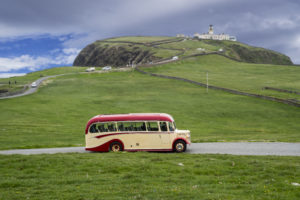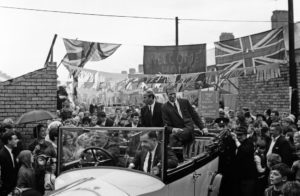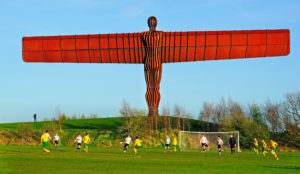“And girl it looks so pretty to me, like it always did; Oh like the Spanish City to me, when we were kids”, purred Mark Knopfler on the Dire Straits track “Tunnel of Love”. “So rock away, rock away; Cullercoats and Whitley Bay.” These lyrics are now carved into the prom at Whitley Bay, before the great dome of the Spanish City, an extraordinary Edwardian edifice that was once the gateway to a celebrated funfair. With its carousels and carnival arcades, it was such a summertime treat for local kids like me.
This corner of North-East England is still not much visited by out-of-towners — competing as it does with the bright lights of Newcastle, Hadrian’s Wall country, and the grandeur of the castles strung along the Northumberland coast from Warkworth to Bamburgh. But this original Geordie Shore has long been Tyneside’s playground.
Just as the Victorians invented industrial life, and the discipline of the factory hooter and dockyard clock, so too did they conceive of leisure as a commodity — best consumed at certain times and in certain demarcated zones, where the railways could whisk you away from the grime and regimentation of industrial towns to the fresh air and freedom of the seaside. In the North-East, the centre of all this was the bottom right-hand coastal corner of Northumberland, where the 12 miles of metal-bashing industry from Newcastle to the sea transformed suddenly into a sea-front dreamland for the middle and working classes. The abrupt change of mood is still palpable, as Tyneside turns to seaside, business turns to pleasure, production to consumption.
By 1911, Britain had over 100 substantial seaside resorts, from the big boys of Blackpool and Brighton to lower league Largs and Llandudno. In its size and proximity to its larger urban neighbours, the Northumbrian Riviera fits somewhere in between these poles, more akin to the maritime resort suburbs of Penarth or Southsea; but like all of them it was a place of beaches, bathing and boarding houses — with a big slug of hedonism.
The ying and yang of refinement and raffishness, primness and vulgarity, recurs both within and between British seaside towns: think of neighbouring Lytham and Blackpool, Hove and Brighton, even Portstewart and Portrush. The Geordie Riviera was like this too, where Tyneside’s wealthy coastal suburbs of stockbrokers’ Tudor villas, Masonic lodges and pristine golf clubs chafed alongside the fleshpots, arcades and rollercoasters of Whitley Bay’s South Parade and Spanish City — where Bank Holidays in my youth were always a grisly bacchanal of fighting and fornication.
Yet Whitley had once been “the Blackpool of the North East”, a major destination for holiday-makers who regularly filled up the B&Bs and caravan sites well into my Eighties childhood, and its attractions were primped and packaged by great commercial artists like Fred Taylor and Tom Purvis for LNER, whose colourful posters are all masterpieces. The most exciting buildings were born in the Riviera’s pleasure-seeking Edwardian heyday — all, tellingly, in the neo-Baroque style. Whitley Bay’s cheerful station, for instance, was built in 1910; with its swagged and garlanded clock tower and Paris Metro style canopy, it became the destination for Tyneside day-trippers and vacationing Glaswegians heading south for marginally warmer climes.
This taste for voluptuous neo-Baroque was in some ways an Edwardian reaction to the severity of Victorian Gothic. So, when the Spanish City was built in 1910, its mammarian dome was second only in size to St Paul’s Cathedral. It was influenced by and contemporaneous with the development of Atlantic City in New Jersey, where the stupendous Marlborough-Blenheim Hotel had been built in 1906. Both places specialised in the architecture of pleasure and sybaritic escapism.
Tynesiders had much to escape from. Northumbria offered the worst housing conditions in England: more Geordies lived in flats and tenements than anywhere outside Scotland. And its staple industries were known as “the hardest work under heaven” — even if the trades were relatively well-paid, providing disposable income for fun and frolics. That Geordies flocked to an Iberian building that exudes the Moorish sensuality of El Andalus, or the dazzlingly white Mediterranean sunlight of a Sorolla painting — decades before the great victory of the Spanish costas over the British seaside — speaks to a yearning romanticism in the Northumbrian soul.
On a summer’s day, it remains a wonderful spot to drink in the scenic views of the coal-streaked sands of Whitley, with the North Sea shimmering like the Bay of Naples. In the distance, perched on a tidal island, is St Mary’s Lighthouse, surrounded by a picturesque setting of cottages, rockpools and the lapping waters of Tyne, Dogger and German Bight. But in the final decade of the 20th century, Whitley suffered years of decline. The peeling paint on the Spanish City’s “Corkscrew” rollercoaster matched the corroding metalwork on the Tyne. When great coastal landmarks like the Tynemouth Plaza — a vast Second Empire-style ballroom and winter gardens — burned to the ground in 1996, it felt like a portent. It was hard to see a bright future for a place whose rise and fall had corresponded so closely to the economic fortunes of Tyneside.
And yet the Northumbrian Riviera is bustling once again. Largely gone are the boarding houses and sticky-carpet bars for hen and stag parties; instead, it’s all about surf cafés, hipster boutiques and vegan cake shops. Not long ago, the Guardian even named Whitley Bay as one of the coolest places to shop. This growing embourgeoisement has been mirrored by the changing politics of the coast. The constituency of Tynemouth — which was once one of the few Tory strongholds in the North-East, home to the very grand Conservative MPs Dame Irene Ward and then Sir Neville Trotter — has been solidly Labour since 1997. Meanwhile, neighbouring Blyth Valley, in the Northumbrian rust belt, having been rock solid Labour since the Thirties, flipped to the Tories in 2019.
The resurgence of this Geordie Shore has been in part down to an active local authority, and the boost from Covid that the British seaside received from day-trippers instead of holiday-makers. But the demographics of the coast have changed too, with growing numbers of younger professionals and their families moving close by. A spot of paddle-boarding out of Cullercoats harbour, a park run along the links, or even just a Di Meo’s ice cream and a bimble along the sea front: these have become favourite pastimes of the aspirational Geordie.
The uses of this place may have changed, but what continues to draw people here is the great beauty of the land and seascape. The American artist Winslow Homer lived in Cullercoats in 1881, and honed his watercolour technique painting the local fisher lasses and the changing moods of the North Sea. The working-class novelist Jack Common recalled sallying forth in the Twenties from industrial Newcastle to North Shields, where “the air was full of the sea glow, a salt radiance brightened all the long Tynemouth streets”. Even Charles Dickens himself came here in 1867, walking from Newcastle to Tynemouth, and, after being knocked over by a wave on Longsands, recorded that “spanning the restless uproar of the waves was a quiet rainbow of transcendental beauty. The scene was quite wonderful.”
That scene, today, is often reminiscent of one of the most reproduced of those railway posters from this riviera’s golden age: British Rail’s depiction of an impossibly good-looking young family, optimistically dressed for the Northumbrian climate, bobbing in the waters by St Mary’s Island, above the legend “Life is Gay at Whitley Bay”. The Geordie Shore is back, if it ever went away.
Disclaimer
Some of the posts we share are controversial and we do not necessarily agree with them in the whole extend. Sometimes we agree with the content or part of it but we do not agree with the narration or language. Nevertheless we find them somehow interesting, valuable and/or informative or we share them, because we strongly believe in freedom of speech, free press and journalism. We strongly encourage you to have a critical approach to all the content, do your own research and analysis to build your own opinion.
We would be glad to have your feedback.
Source: UnHerd Read the original article here: https://unherd.com/




